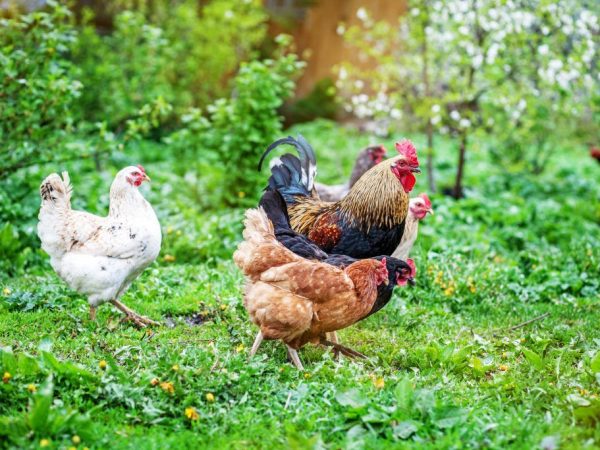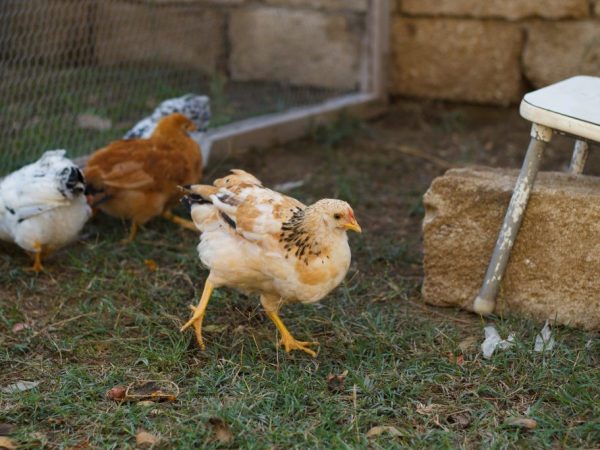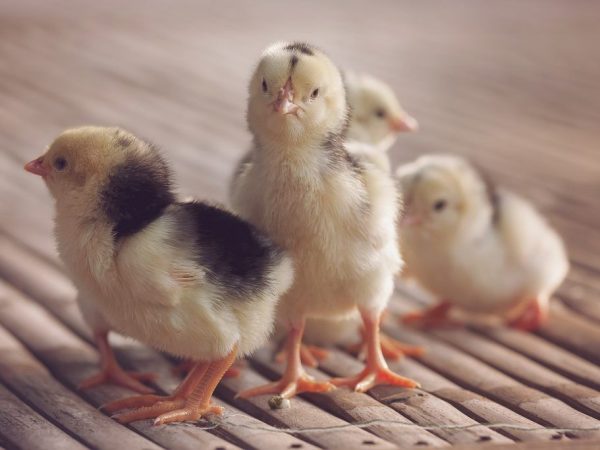Description and characteristics of chickens of the Tricolor breed
Broiler Tricolor is a fairly popular type of poultry, which is cultivated by farmers in many countries. Interest in this breed of birds began to show not only large factories, but also simple farms.

Description and characteristics of chickens of the Tricolor breed
Chickens Tricolor as an independent breed appeared relatively recently. They were bred by French scientists-breeders, who had previously conducted more than a dozen experiments in order to improve local breeds, while simultaneously receiving a fast pace of chicken development, good weight gain and an exquisite taste of meat. If you follow the description of the breed, you can find a lot of common characteristics that connect the Tricolor chickens and other representatives of the breeds bred in France. But the main difference is that this bird is raised only to get tasty dietary meat.
General characteristics of the breed
If you look at the photos and compare the Tricolor broilers with other birds, on the basis of this we can conclude that the appearance of these birds is very interesting: they mainly differ in a variety of color shades of feathers.

The appearance of Tricolor chickens
In addition, the description of the breed suggests the following:
- The weight. An adult male (rooster) on average gains 4-5 kg, a laying hen usually weighs less, maximum - up to 4 kg.
- Lower limbs. Chickens of the Tricolor breed have rather long legs, which, like the beak, have an intense yellow hue.
- Feathers. In the photo on the Internet, you can see that this breed is most often characterized by a tricolor color. It is for this reason that these birds got their name, plus this they may differ from the rest. Kluchee look really unusual (unique) and even decorative. Especially if they are white, but have small inserts of black and reddish-brown shades. There are chickens with a reddish sternum, a black mane with white splashes and the same back. The description says that these birds have dense plumage with a small percentage of fluff.
- Head. The tricolor broiler has a slightly larger head, but since it is large, it looks quite natural against the background of the body. Earlobes, comb and earrings are large-sized, painted in a deep red color. The eyes are dark orange (closer to brown) and very expressive, but their gaze is not aggressive.
The most striking difference between birds of this breed is their body. The physique of chickens of the Tricolor breed is massive, has a horizontal landing. They have an ovoid body shape on high and powerful legs. Smooth contours of the figure, which are perfectly combined with a well-defined muscle relief.
Egg production of the breed
Quite often there is an opinion that the Tricolor is a breed of chickens suitable only for meat directiontherefore chickens are not useful as layers. But the general characteristic from the breeders assures the opposite.hens show the maximum results of egg production, they cannot be compared with the usual breed of layers.
The period of puberty in hens of the Tricolor broiler breed begins at an average of 4 months of age. This time period is characterized by the beginning of active masonry, so you need to establish the whole process as soon as possible. Tricolor chickens lay an average of 250-300 eggs per year. If the breeder carefully monitors the diet, then the chickens can be used to obtain eggs. The shell color is pale pink or milky cream. weight - on average from 5 to 62 g.
The nature of the birds
The bird does not require special conditions for growing, because it is distinguished by a certain phlegm, calmness and slowness. Such winged ones will not spend the whole day on the walking area; rather, leisurely walks in search of something tasty are suitable for them.
The maintenance and breeding of this breed is very attractive for those who own small poultry houses, because they exist absolutely calmly in a confined space. In addition, broilers quickly adapt to the presence of people, so being around them is not stressful.
Maternal instincts
The crosses are not suitable for easy (natural) breeding. These clucks have almost completely lost their maternal instincts, so they are not suitable for hatching offspring.
But this is not the only reason why tricolors are not suitable for the role of a brood hen. Since the bird is heavy, it can simply crush the eggs. Most farmers breed birds for meat, so most individuals go to slaughter before the age of offspring is suitable.
Features of the development of chickens of the Tricolor breed
The photo of the young shows that the chicks adopt the best characteristics from their parents.

Chickens of the Tricolor breed
Recent generations have not lost the standard characteristics at all.
- Chicks have a good appetite, which is caused by the rapid pace of physical development, so these chickens have a great need for a correct, and most importantly, a balanced diet, rich in vitamins and minerals.
- Young animals fledge more slowly. For this reason, chicks need to constantly maintain a stable microclimate. Feathers grow slowly and unevenly - if the bird is overcooled, it can easily get sick.
- Growth rate is not identical to plumage coverage. It is typical for broiler hybrids, at the age of one month the chicks weigh more than 1.5 kg. After a month, they gain another kilogram, such an accelerated growth is characteristic up to 5-6 months, after the young growth slows down.
The survival rate of hybrid tricolor chicks is quite high - 90-92%. But if the manufacturer provides good living conditions, the indicator only increases.
With full care in a home or farm environment, the breed gives out 100% of the survival rate of offspring. In addition, adult chicks quickly go through the period of growing into full-fledged individuals.
Rules for the production and rearing of chickens
Professionals advise paying attention to the indoor climate. That is, in raising young animals, it is important that the environment has a normal stable temperature background and air humidity. During the first 2 weeks of life, the chicks will feel comfortable in a room where the air temperature is not more than 30 ° C, and the humidity is 5-60%. As the pups develop, the entire thermoregulation mechanism begins to develop, so the ambient temperature can be gradually reduced.
- It is very important that the young have adequate access to water. It should be clean, and in the early days it will need to be diluted warm. To improve health, you can add chamomile broth, which has antibacterial properties and acts as a prophylactic agent against infections.In addition, it is allowed to solder the chicks with weak tea, glucose syrup, which improves and strengthens the immune system.
- Chickens' meals should be scheduled by the hour. For the first days of life, the regimen provides 6 meals a day. Further, as you grow older, the number of meals is reduced to 3.
- It is advisable to give the chicks specialized grain mixtures, which are compiled based on the basic needs of the three-flowered flowers. If a person grows a bird at home, it is allowed to use broiler feed... It is undesirable for young animals to make the mixture on their own, since an inexperienced person in this matter can harm the chicks, since he has little knowledge of the feeding norms.
You can replenish vitamin reserves by adding boiled vegetables, herbs or medicines containing all the necessary microelements to the feed, but only in the form of a concentrate. As a solution to the problem, you can buy a small dropper and drip vitamins into the bird's mouth.
The main thing in this matter is to do everything right, because the chicken needs to be fixed. If a person does not calculate the strength, it is quite possible that this will be the last vitamin replenishment procedure for the chick.
Keeping adult birds of the Tricolor breed
There are a number of rules that you need to pay attention to in order to create the best possible conditions for broilers to function.
- These birds have enemies: high levels of humidity, dirt and drafts. Given the fact that this broiler is a hybrid that has a high survival rate, the lack of normal living conditions reduces the protective functions in the body.
- These French women are very difficult to survive the Russian winters. Of course, for the middle lane, the birds normally survive the cold period in an unheated room, but if the producer lives in the northern part of the country, you need to take care that the chicken coop has a well-established heating system... On average, the optimum temperature in winter is up to 15 ° С and not lower than 11 ° С.
- The farmer needs to prepare several floor mats for the maintenance. An extreme measure of keeping tricolor broilers in cages does not affect the emotional state. But because of such a sedentary lifestyle, they may develop obesity. And this is a big problem for producers, as the taste characteristics of meat deteriorate.
Molting period begins even in chicks, which change fluff to normal feathers. Further, adults molt only once a year, most often this time falls on the autumn period.
At this time, not all layers stop laying eggs, although this break in egg production only helps broiler hybrids to molt faster. During this period, birds are especially vulnerable to disease. At this time, especially careful care is important for them.
Pros and cons of the breed
For its category, this breed is equated to one of the best, some argue that it is ideal. After all, she is growing rapidly, so she is ready for slaughter already at 2-3 months of age. Adults, which are responsible for the offspring, can be kept for a maximum of two years. But at this time, the chickens have a decrease in the level of egg production.
- She is ranked among the meat, but also has good egg production.
- Unpretentious, quickly adapts to cellular living conditions.
- Hardy, docile and calm character.
The only significant drawback is that they have a weakly expressed maternal instinct, which is quickly compensated for by the presence incubator... The egg for incubation incubation must be selected especially carefully.
If the little hen has hatched the offspring by itself, you do not need to worry, she will drive the baby and protect them. The main thing is not to put unnecessary stress on the bird during the incubation period and to provide it with everything it needs.


